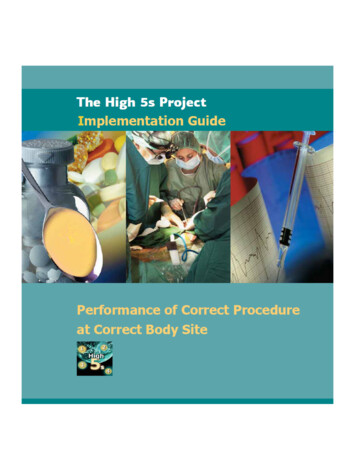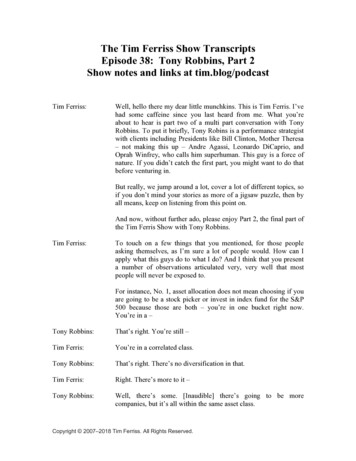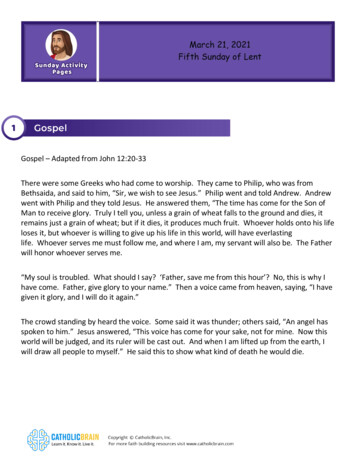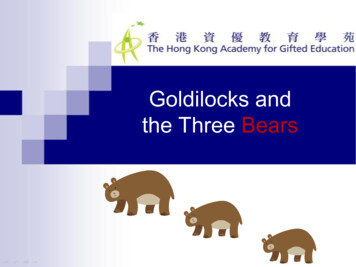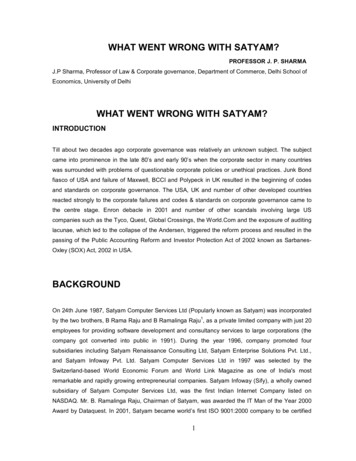
Transcription
WHAT WENT WRONG WITH SATYAM?PROFESSOR J. P. SHARMAJ.P Sharma, Professor of Law & Corporate governance, Department of Commerce, Delhi School ofEconomics, University of DelhiWHAT WENT WRONG WITH SATYAM?INTRODUCTIONTill about two decades ago corporate governance was relatively an unknown subject. The subjectcame into prominence in the late 80’s and early 90’s when the corporate sector in many countrieswas surrounded with problems of questionable corporate policies or unethical practices. Junk Bondfiasco of USA and failure of Maxwell, BCCI and Polypeck in UK resulted in the beginning of codesand standards on corporate governance. The USA, UK and number of other developed countriesreacted strongly to the corporate failures and codes & standards on corporate governance came tothe centre stage. Enron debacle in 2001 and number of other scandals involving large UScompanies such as the Tyco, Quest, Global Crossings, the World.Com and the exposure of auditinglacunae, which led to the collapse of the Andersen, triggered the reform process and resulted in thepassing of the Public Accounting Reform and Investor Protection Act of 2002 known as SarbanesOxley (SOX) Act, 2002 in USA.BACKGROUNDOn 24th June 1987, Satyam Computer Services Ltd (Popularly known as Satyam) was incorporated1by the two brothers, B Rama Raju and B Ramalinga Raju , as a private limited company with just 20employees for providing software development and consultancy services to large corporations (thecompany got converted into public in 1991). During the year 1996, company promoted foursubsidiaries including Satyam Renaissance Consulting Ltd, Satyam Enterprise Solutions Pvt. Ltd.,and Satyam Infoway Pvt. Ltd. Satyam Computer Services Ltd in 1997 was selected by theSwitzerland-based World Economic Forum and World Link Magazine as one of India's mostremarkable and rapidly growing entrepreneurial companies. Satyam Infoway (Sify), a wholly ownedsubsidiary of Satyam Computer Services Ltd, was the first Indian Internet Company listed onNASDAQ. Mr. B. Ramalinga Raju, Chairman of Satyam, was awarded the IT Man of the Year 2000Award by Dataquest. In 2001, Satyam became world’s first ISO 9001:2000 company to be certified1
by BVQI. In 2003, Satyam started providing IT services to World Bank and signed up a long termcontract with it. IN 2005, Satyam was ranked 3rd in Corporate Governance Survey by GlobalInstitutional Investors.PROBLEMS BEGINthProblems in Satyam begin when on December the 16 , 2008; its chairman Mr Ramalinga Raju, in asurprise move announced a 1.6 billion bid for two Maytas companies i.e. Maytas Infrastructure Ltdand Maytas Properties Ltd saying he wanted to deploy the cash available for the benefit of investors.The two companies have been promoted and controlled by Raju’s family. The thumbs down given by2investors and the market forced him to retreat within 12 hours. Share prices plunges by 55% on3concerns about Satyam’s corporate governance . In a surprise move, the World Bank announced on4December 23, 2008 that Satyam has been barred from business with World Bank for eight years for5providing Bank staff with “improper benefits” and charged with data theft and bribing the staff. Shareprices fell another 14% to the lowest in over 4 years. The lone independent director since 1991, USacademician Mangalam Srinivasan, announced resignation followed by the resignation of three moreindependent directors on December 28 i.e. Vinod K Dham (famously known as father of the Pentiumand an ex Intel employee), M Rammohan Rao (Dean of the renowned Indian School of Business)6and Krishna Palepu (professor at Harvard Business School) . At last, on January 7, 2009, B.Ramalinga Raju announced confession of over Rs. 7800 crore financial fraud and he resigned aschairman of Satyam. He revealed in his letter that his attempt to buy Maytas companies was his lastattempt to “fill fictitious assets with real ones”. He admitted in his letter, “It was like riding a tigerwithout knowing how to get off without being eaten”.7Satyam’s promoters, two brothers BRamalinga Raju and B Rama Raju were arrested by the State of Andhra Pradesh police and the8Central government took control of the tainted company. The Raju brothers were booked forcriminal breach of trust, cheating, criminal conspiracy and forgery under the Indian Penal Code. TheCentral Government reconstituted Satyam's board that included three-members, HDFC ChairmanDeepak Parekh, Ex Nasscom chairman and IT expert Kiran Karnik and former SEBI member CAchuthan. The Central Government added three more directors to the reconstituted Board i.e., CIIchief mentor Tarun Das, former president of the Institute for Chartered Accountants (ICAI) TNManoharan and LIC's S Balakrishnan.A week after Satyam founder B Ramalinga Raju’s scandalous confession, Satyam’s auditors PriceWaterhouse finally admitted that its audit report was wrong as it was based on wrong financial9statements provided by the Satyam’s management. On January 22, 2009, Satyam’s CFO SrinivasVadlamani confessed to having inflated the number of employees by 10,000. He told CID officialsinterrogating him that this helped in drawing around Rs 20 crore per month from the related but2
fictitious salary accounts. Andhra Pradesh State CB-CID raided the house of Suryanarayana Raju,the youngest sibling of Ramalinga Raju who owned 4.3 per cent in Maytas Infra, and recovered 112sale deeds of different land purchases and development agreements.10Senior partners SGopalakrishnan and Srinivas Talluri of the auditing firm PricewaterhouseCoopers (PwC) werearrested for their alleged role in the Satyam scandal. The State’s CID police booked them, oncharges of fraud (Section 420 of the IPC) and criminal conspiracy (120B).11TECK MAHINDRA ACQUIRED SATYAM, RENAMED IT AS MAHINDRASATYAM AND REPLACED ITS EXECUTIVE BOARD AND AUDITORSMerely four months after its founder B. Ramalinga Raju admitted to fudging the books, Satyam’sgovernment appointee six-member board managed to salvage the company despite all odds. Theboard, which kicked off the global competitive bidding process12in March 2009, selected Venturbay13Consultants, a subsidiary of Tech Mahindra, as it emerged as the highest bidder at rupees 58 pershare. The deal got the approval of Company Law Board.14Consequently, Tech Mahindra (holding1531% stake in Satyam) bought Satyam renaming it on June 21, 2009, as ‘Mahindra Satyam’andreplaced its executive Board by appointing its (Tech Mahindra) CEO and MD Vineet Nayyar as ViceChairman (who in December 2009 was promoted as Chairman), its international operations head CPGurnani as CEO and Subramaniyam Durgashankar as CFO. The executive Board appointedDeloitte Haskins & Sells as the company’s statutory auditors to restate its accounts.SWIFT GOVERNMENT ACTION SAVED SATYAM ULTIMATELYOn January 7, Ramalinga Raju emailed his resignation to market regulator SEBI admitting tofinancial irregularities, which, in less than two hours, was forwarded to the Ministry of CorporateAffairs (MCA).The same day, the Ministry asked its two wings the Institute of CharteredAccountants of India (ICAI) and the Institute of Company Secretaries of India (ICSI) to inquire intothe role of auditors and company secretaries for swift regulatory action. There was an emergencythinter-ministerial meeting next day ie on 8 although it was a government holiday. Concurrently, the16Ministry was drafting the petition to be filed before the Company Law Board (CLB) . The very nextday, the Ministry got the CLB order superseding the Satyam board with government appointeddirectors. SEBI relaxed the take-over code per se on an application by the Satyam board to meet theemergency like Satyam where government suspended the board of a company and appointeddirectors who act for the public good without any payment or compensation. Clearly, the Ministry ofCorporate Affairs (MCA) acted swiftly and thoughtfully and saw the issue as much larger than that ofan individual company. Satyam could not have been saved if there was any delay in decision-3
making at the government level. Investigations also progressed as swiftly as the process of rescuingSatyam. A Satyam like situation in the US would not have allowed the government to act on behalfof the shareholders and appeal to the judicial authority concerned.17MAHENDRA SATYAM AND TECH MAHINDRA TO MERGEThe Mahindra Group, the new owner of Satyam and the largest shareholder in Tech Mahindra, is setto merge the two companies to transform the combined entity into an Information andCommunication Technology (ICT). The merger can happen any time in the near future since theaccounts of Satyam have been re-stated.MAHINDRA SATYAM HAS BRIGHT FUTUREGiven that Tech Mahindra has only 25,429 employees, the acquisition of a company bigger thanitself may have its own challenges. While combined employee strength85,167 of Tech Mahindraand Mahindra Satyam may make Tech Mahindra next only to India’s third largest IT servicesprovider Wipro, managing the integration may not be easy. It is going to be an uphill task forMahindra and Mahindra group to clean up Satyam and make it run profitably again, given allliabilities and reputation issues. The table 1 clearly reveals the position of “Mahindra Satyam”(formerly Satyam) amongst the prominent IT companies in the country.18Table 1-Mahindra Satyam has Bright FutureCompanyEmployees(2009-10)Revenue(2009-10)Net ,27893413822,2732685681IGATEPatni IGATE4
Tech Mahendra33,5244,484743Mahendra Satyam51,6435,101-71thTech Mah Mahendra Satyamth85,167 (5 )9,584 (5 )th672 (6 )Source: Updated version of figures given in the India Today, April 27, 2009, p 47.Following a sharp rally seen in its share price, “Mahindra Satyam“ (formerly Satyam) capitalizationhas grown quit substantially, placing it among the 100 most-valued firms in IndiaSatyam (nowMahindra Satyam), which, prior to its fall, was India’s 4rth most-valued IT firm after Infosys, TCS andthWipro, now ranks at the 6 position among IT companies after TCS, Infosys, Wipro, HCL Tech,thOracle and Tech Mahindra and at the 97 spot among the top 100 companies.19Mahindra Satyam recorded profit for the first time in the first and second quarter of the fiscal year2011 after being hit by the country’s largest corporate fraud. Thus, company, once ranked thecountry’s fourth largest IT firm, is on the path to recovery. For the second quarter ended September30, 2010, Mahindra Satyam recorded revenues of Rs 1242.4 crore while the profit stood at Rs 23.3crore. This was lower than the first quarter of financial year 2011 when it registered a profit of Rs97.5 crore on sales of Rs 1248 crore. This fall in profit may be mainly on account of wage hike andforex fluctuations.20Mahindra Satyam had earlier declared a net loss of Rs 8176.8 crore for FY2008-09, when the company was under Satyam founder B. Ramalinga Raju and shown a muchlower net loss of Rs 124.6 crore for the FY 2009-10.21CHALLENGES AHEADA year after Raju's shocking confessions, Satyam (now Mahindra Satyam) is back in business, but ahost of financial, legal and customer or pricing challenges continue to trouble the company that wasonce the fourth largest IT player in India. In the first few months after the takeover, the newmanagement in Mahindra Satyam spent its energy on traveling, meeting key customers, andreassuring them that it was business as usual at Satyam. A few customers like State FarmInsurance had moved to rivals even before the new owner and management came on board. Others,shaken by the scam, decided to de-risk and move. One of the most high-profile losses was that ofBritish Petroleum’s 1-billion contract, which moved to TCS and Wipro. British Petroleum used tooutsource projects worth 50m annually to Satyam. A few big names such as GE, a top customer,and GSK stayed on but extracted their pound of flesh. In July last year, GSK signed a five-yearmulti-million dollar SAP contract with Mahindra Satyam, and in September, GE extended its multi-5
million dollar contract for the next three years. They asked for 15-20% rate cuts across the vendorbase, and Mahindra Satyam was no exception.22PROGRESS OF INVESTIGATIONSA lot has changed for Satyam ever since the founder chairman Ramalinga Raju confessed the Rs7000 crore fraud; new owner, a brand new board, new CEO and CFO; new auditors, and theinvestigations into the scam are on full swing. Succeeding paragraphs provide the status ofinvestigations.SFIO INVESTIGATIONSThe Serious Fraud Investigation Office (SFIO),23a multi-disciplinary investigating arm of the Ministryof Corporate Affairs, set up in 2003 with officials from various law enforcement agencies, was askedto investigate the fudging of accounts as admitted by B. Ramalinga Raju. It submitted its preliminaryreport on April 13, 2009 that runs into 29 volumes contained in 14 thousand pages. On November30, it filed case24against Satyam promoter B Ramalinga Raju, his brother B Rama Raju, ex-CFOVadlamani Srinivas, senior finance manager D. Venkatapathy Raju and finance manager C.Srisailan, along-with company’s former statutory auditors S Gopalakrishna and Srinivas Talluri25under various provisions of the Indian Penal Code, Companies Act and IT Act. The SFIO reportbelieved the confession was not out of Raju’s call of conscience; rather it was deliberately painting adistressing face to keep the legal and public dealings with a light hand. According to SFIO report,Satyam founders B Ramalinga Raju, B Rama Raju and ex-CFO Vadlamani Srinivas, and ex-vicepresident (finance) G Ramakrishna, together hatched a conspiracy to artificially increase therevenues and profits in the books. The report highlights that the falsification was done by deliberatelyleaving loopholes in the Computerized Accounting System which uses ERP modules. The high-levelapplication landscape of Satyam internal applications has many links between various systemswhere either there was no integration or there was weak integration. These loopholes weredeliberately left to insert fictitious invoices and fictitious bank statements to balance them withoutbeing detected. Very smartly fictitious invoices were created in the invoice management systemusing regular login ids, falsely intimating that any of the employees could be involved in this. In orderto cover up these fictitious entries, the receipts were first accounted with Bank of Baroda, New Yorkbranch, (account no- 120559) and they then were relocated as fixed deposits in other accounts. Withsuch artificial entries started giving a blooming picture of the company, the management decided toput the surging profits in better investments. Unfortunately, Raju was now forced to make6
investments from the non-existing investments. But fate had something else in store. After raisingmoney, Raju disembarked them in losing propositions. As the company was constantly losingmoney, Raju decided to venture into brand building to avoid bad circumstances. It was then thepromoter-directors of the company started commissioning on these inflated profits, which is again anoffence under IPC. The SFIO probe also takes a call on the account statements of the company withthe Bank of Baroda highlighting jacking up of the books ever since 2001-02. The report also clarifiesthat the company had booked false fixed deposits and interests in five banks namely, ICICI, HSBC,HDFC, BNP Paribas and Citi Bank. On the reconciliation of these statements the company booksshowed major gaps with the actual existing deposits. The SFIO has also booked this offence undervarious sections of IPC and the Companies Act. The investigation also throws light on the company'spaying excess taxes on the non-existing assets and also indulging in forging current accountbalance statements. This helped the company forge quarterly details of outstanding balances offixed deposits and interest earned on them. The report says that by showing a rosy picture of thecompany, the promoters were jacking up the share price and simultaneously selling off their holdingsraking in handsome money. The company, apart from this, is also believed to have issued AmericanDepository Shares worth 15.2 crore out of which only 5.25 crore were brought in to the country.After detailed investigation, the company was unable to convince the SFIO on the false amount. Theallocation of this amount is now considered to be under the Enforcement Directorate. Thus, thereport unveils the entire scam with proofs of all false claims.26The SFIO investigations also throws light on the company's desperate attempt to acquire MaytasInfrastructure (MIL) and Maytas Properties (MPL), an act done under the pressure from externalinvestors who were pressing for better use of liquid asset shown in the balance sheet. The reportstates that the promoters Ramalinga Raju, Rama Raju and the CFO Srinivas Vadlamani were fullyaware of the precarious financial position of the company and the large number of fake fixed depositand fake bank balances created in the books since 2000-2001 onwards. “A facade was created inthe form of proposed acquisition of MIL and MPL to replace fictitious assets of Satyam with realassets with intent to deceive the shareholders of MIL and MPL and to fraudulently induce them todeliver their shares to Satyam,” the SFIO report states. The Report further states “in the meeting thattook place on December 16, 2008 to discuss the acquisition of MIL and MPL, B Ramalinga Raju waspresent, but abstained from discussion and voting of these proposals. V Srinivasan, ex-CFOinformed the members that the evaluation of Maytas Infra was based on SEBI (SubstantialAcquisition and Takeovers) Regulations, 1997 and for Maytas Properties, based on evaluation doneby Ernst & Young. Further, the consent of the board was unanimously accorded after which Rajuproposed the merger of MIL and MPL to the shareholders, which came in for stiff resistant, and issueof corporate governance was raised.” A couple of weeks later, Ramalinga Raju dropped a bombshellby sending a letter of admission to SEBI and the board of directors that he had fudged the accounts7
of Satyam and that the balance sheet as on September 30, 2008 carried an inflated (non-existent)cash and bank balances of Rs 5040 crore, non-existent interest of Rs 376 crore and understatedliability of Rs 1230 crore27as has been highlighted in table 2.Table 2: Two Versions of Satyam’s AccountsTWO VERSIONS OF SATYAM’S ACCOUNTS(I)c)SOURCES OF FUNDS(1) Shareholders FundsShare capitalShare application money,allotmentReserves and surplusa)b)(2) Loan FundsSecured loansUnsecured loans- othersa)b)(I)a)b)c)d)a)b)pendingAPPLICATION OF FUNDS(1) Fixed Assets(2) Investment(3) Deferred Tax Assets (net)(4) Current Assets, LoansAdvancesSundry debtorsCash and bank balancesInterest accrued on fixed depositsLoans and advancesLess: current liabilitiesLiabilitiesProvisionsBEFORE CONFESSIONAFTER 01.21)1217.28andGap of Rs.5040 croresin cashInterest notexistingand provisionsNet Current AssetsSource: The Business Today, February 8, 2009, p50.CBI INVESTIGATIONSCentral Bureau of Investigations (CBI) in February 2009 registered a case of cheating, forgery andcriminal conspiracy against Ramalinga Raju and several other directors and auditors who workedwith the company.28The FIR mentions several Indian Penal Code (IPC) sections including 120B(criminal conspiracy), 409 (criminal breach of trust), 420 (cheating), 467 (forgery of valuable security,will), 468 (forgery for cheating, 471(using forged documents as genuine) and 477-A (falsification ofaccounts).29The CBI, investigating diversion of Satyam funds abroad, have identified threesuspicious foreign bank accounts in the US, which are held in the name of three different individuals.About rupees 60 crore belonging to Satyam were channelized into the accounts that stand in the8
name of these three non-Indian persons. The CBI did not find these transactions reflected in30Satyam’s books.On April 7, 2009, the CBI had filed a charge sheet against Ramalinga Raju and eight others undervarious sections of the Indian Penal Code for cheating and forgery and submitted 1532 originaldocuments of bank transactions and 65,000 pages of other documents, which included thestatements of 432 witnesses in the case along with the charge sheet.31In a 200 page supplementarycharge sheet filed on November 24, CBI charged the accused of forging board resolutions andunauthorisedly obtaining loans worth rupees 1220 crore from banks as well as inflating Satyamrevenues to the tune of rupees 430 crore by creating fake customers and generating fake invoices.The rupees 1220 crore unauthorized loan detailed by the CBI are not reflected in the company’sbooks and are over and above the rupees 1230 crore that Ramalinga Raju confessed to Satyamhaving received from various family owned companies including Mytas Infra and Mytas Properties.The charge sheet also identifies 1065 properties with a documented value of rupees 350 crore thatwere acquired by the Rajus with the spoils of the fraud. These include 6000 acres of land, 40,000 sqyd of housing plots and 90,000 sq ft of built up property. The CBI on November 21 arrestedthSatyam’s internal audit head VS Prabhakar Gupta making him the 10 accused.32rdThe CBI on January 7, 2010 filed a 3 charge-sheet against six persons in the Satyam scam. Thecharges were filed before the Additional Chief Metropolitan Magistrate, Nampally, Hyderabad aftercompletion of investigations. Besides Satyam’s former chairman B Ramalinga Raju, the others whohave been charged are then managing director and Raju's brother B Rama Raju, then chief financialofficer (CFO) Vadlamani Srinivas, then vice-president (finance) G Ramakrishna and two auditors ofBangalore based private company PriceWaterhouse Coopers (PwC) S Gopalakrishnan and SrinivasTalluri. The 30-page charge-sheet contains 32 documents and cites 26 witnesses. Thedocumentation runs into 3,552 pages. In the fresh charge-sheet, the CBI has brought out evidenceagainst the accused on the allegations of filing false Income Tax (IT) returns with fraudulent anddishonest intentions of cheating the shareholders and thereby causing wrongful loss to Satyam.According to the charge-sheet, the accused persons squandered the money in violation of the trustbestowed on them by the shareholders of the company in order to conceal their fraudulent anddishonest deeds of inflating income on account of fictitious sales and interest on non-existent fixeddeposits by violating the law and corporate ethics made Satyam to suffer an estimated loss of Rs126.57 crore. Further, the accused had inflated the revenue of the company by infusing false andfictitious sales invoices and shown the amount received and deposited as fixed deposits in variousscheduled banks. Due to this inflated revenue and the inflated income in the form of interest on thenon- existent fixed deposits, an additional tax liability to the tune of Rs 526.37 crore was created onthe company. Subsequently, the charge sheet says, by taking recourse to the provisions of section9
90 and 91 of the IT Act, the accused in furtherance of the conspiracy showed higher tax remittancesin foreign countries to get relief from the tax chargeable in India. Thus, they achieved by showingincome on the non-existent revenue as part of the income of the overseas branches of Satyam whilefiling IT returns in India.33A whistleblower (Hyderabadi origin UK National settled in London) who contacted CBI at his ownhas told the investigating agency that six bank accounts and fictitious firms that the founderRamalinga Raju had floated in London had served their purpose and were liquidated long before thescam came to light. The six companies and bank accounts which were operated from London werestarted in 1999 and closed down just before the listing of Satyam’s ADRs on New York StockExchange in May 2001.These accounts and fictitous firms were clearly part of Raju‘s modusoperandi to divert Satyam‘s funds.34ENFORCEMENT DIRECTORATE PROBEEnforcement Directorate (ED) has attached in all 347 properties so far worth over Rs. 1000 crore ofRamalinga Raju, his relatives and others on the charge of money laundering. In August 2010 ED hastaken possession of 4000 acres belonging to Raju family in Loyapalli village near Ibrahimpatnam ofRanga Reddy district in the State of Andhra Pradesh. The Property in Loyapalli is one among 347properties attached is the single largest. Taking physical possession includes installing a board that35property belongs to Government.ED issued provisional attachment order attaching three flats thatwere lying in the names of spouses of Raju brothers-Nandini Raju, Radha and Jhansi Rani, inBanglore’s prestigious Omega Towers spread over 4800 square feet each, the purchase value ofthese three flats is shown at rupees 81 lakh each. Apart from this ED authorities also attached36agricultural plots acquired in Chennai and other areas.An interesting fact that ED investigationshave brought to light is that several gardeners, truck drivers and others, who were working in themango gardens and orchards belonging to Raju family for meagre salaries of Rs 4000 to Rs 5000per month, have been found to possess more than 50 acres of land worth crores of rupees. Majorityof these lands are situated in a single village (called Loyapalli). Raju brothers had purchased asmuch as 4200 acres of land in this village alone in 2006 valuing at present over 4000 crores ofrupees (though official records state that the entire land was purchased for a mere Rs 30 crore).When the ED sleuths interrogated the gardeners on their source of income, they revealed that theland was purchased by the Raju brothers through SRSR Holdings Company and the sale deeds andother papers were lying with them. Later, these workers were made directors of several fictitiouscompanies floated by Ramalinga Raju.3710
SEC INVESTIGATIONSA team of American capital market regulator Securities & Exchange Commission (SEC) came toIndia following filling of a dozen of class action lawsuits38in US against promoters and managementof Satyam on behalf of investors who purchased ADRs of the Co. The SEC has completed its probein India into the multi-crore rupee Satyam fraud, especially the role of external auditors. The SEC39team has conducted detailed discussions with CBI and other investigating agencies. Since therenamed company Mahindra Satyam has now settled most of the claims filed in US, SEC has notmuch role to play now.SUPREME COURT CANCELS RAMALINGA RAJU’S BAILPrime accused Ramalinga Raju moved the Supreme Court for bail in March, 2010 on health ground.But, the apex court rejected his bail application on the apprehensions that he might influence thewitnesses.GOVERNANCE FLAWS NOTICEDFollowing are the common governance problems, which have been noticed in the collapse ofSatyam:UNETHICAL CONDUCTIn Satyam’s case, for its founder B.Ramalinga Raju, honesty was not something that he wanted topursue as hard as profits. He wanted to make money any which way by avoiding paying taxes,cooking books, and pay offs.40Ironically, the word ‘Satyam’ means ‘truth’ in Sanskrit language, butRaju’s admission accompanied by his resignation shows the company had been feeding investors,shareholders, clients and employees a steady diet of ‘asatyam’ (or untruth), at least on its financialfront. Did Satyam’s Boss B. Ramalinga Raju while leading the company followed the spirit behind itsname, certainly not? He on January 7, 2009 revealed some alarming truths that he was concealingfor a long period by confessing to a fraud of Rs 7800 crores ( 1.47 billion) on Satyam’s balancesheet. He and his brother B. Rama Raju who was Satyam’s managing director, had disguised all thisfrom the company’s board, senior managers and auditors for several years. The unfolding of thestory behind the confession reveals the fraudulent and unethical character of a man who till veryrecently bagged number of awards on good corporate governance.11
There was no explicit or implicit code of ethics surrounding Satyam’s corporate culture; bribery,corruption, and exchange of favors, within and outside the company, appear to have occurred withrdfrequency at various levels. It was too late when World Bank in the 3week of December, 2008publicized Satyam’s unethical work culture by announcing Satyam being imposed with charges ofdata theft and bribing the staff and was barred from business with World Bank for eight years forproviding Bank staff with “improper benefits”. Ethical standards thus in the company were poor.Both the CEO and CFO have been charged putting self-interests ahead of the company's interests.They were actively selling large portions of their shareholdings in the company a few months beforethe confession of scandalous fraud. The company’s most senior executives behaved unethically andthere was no evidence of basic moral conduct or behavior at the top executives’ level that exploitedthe company's resources for personal gain for several years. The internal controls appear not tohave detected the fraudulent activities for an extended period of time. Satyam received the WorldCouncil for Corporate Governance’s Golden Peacock Award for excellence41in corporategovernance, indeed; there is a strong case for World Council for Corporate Governance to assess itsown methodology in selecting the winner for their awards. Withdrawing the 2002 award today afterthe blunder has been done does not protect the Council’s reputation.A CASE OF INSIDER TRADINGInvestigations into Satyam scam by the C
J.P Sharma, Professor of Law & Corporate governance, Department of Commerce, Delhi School of Economics, University of Delhi WHAT WENT WRONG WITH SATYAM? . companies such as the Tyco, Quest, Global Crossings, the World.Com and the exposure of auditing lacunae, which led to the collapse of the Andersen, triggered the reform process and resulted .

![Om namo bhagavate vasudevaya [] satyam param dhimahi](/img/30/thousand-blessings-mantra.jpg)


